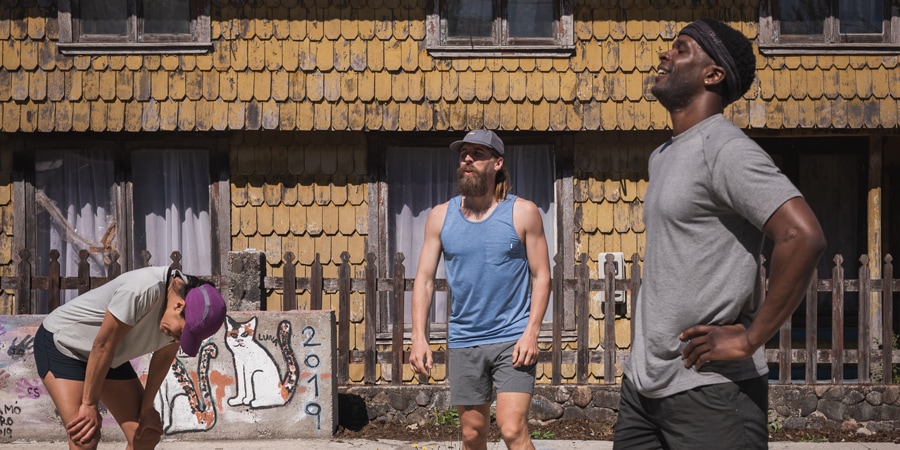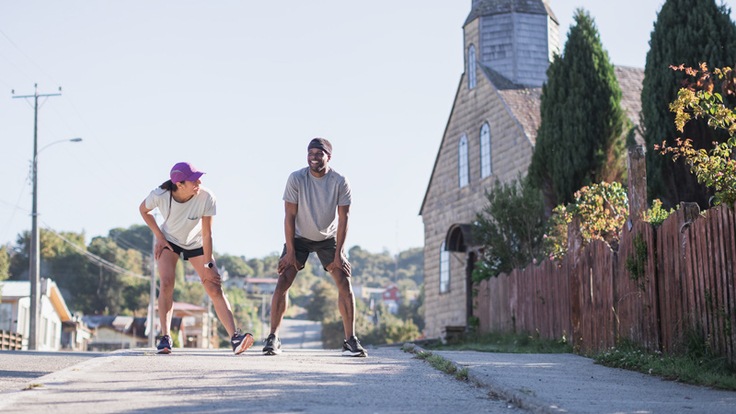We've all been there: Within minutes of launching into a run, you're huffing and puffing and totally out of breath. Difficulty catching your breath during high-output activities like running can make exercise uncomfortable. Yet with the proper technique and a little practice, you can breathe through workouts and even improve your performance as a runner, whether you're a beginner or more advanced.
Always check with your doctor before beginning a new exercise routine. If your breathing is uneven and labored and you think you may be experiencing exercise-induced asthma, a respiratory infection or other health condition, stop immediately and consult with a medical practitioner before continuing.
This guide covers:
- How to Breathe While Running
- Other Tips for Breathing While Running
- What to Do When You're Out Of Breath
- Good Running Posture for Optimal Breathing
- Running at High Altitude and in Cold or Hot Weather
How to Breathe While Running
Most of the time, breathing comes naturally. You do it without thinking. But consider this: Breathing intentionally can help you become more efficient and research shows that certain breathing methods may even improve your performance as a runner. We all breathe differently—through our noses, our mouths or some combination of the two. First figure out what kind of a breather you are. Go for a walk or run and pay attention to how you breathe.
Most runners breathe through a combination of nose and mouth breathing, but research suggests that nose breathing—inhaling through your nose and out through your mouth—can bring more oxygen to your brain and your muscles. Your nostrils also filter allergens and add moisture to that inhaled air.
Breathing through your mouth may lead to constricted, shallow breathing; it can also make your mouth feel dry. That said, nose breathing isn't for everyone, and research on the potential benefits of this style of breathing is still being conducted. As always, stick with what works best for you.
Follow these steps to practice nose breathing:
- Lie down: Start by sitting or lying down on your bed, a couch or the floor.
- Prepare your body: Place one hand over your heart and one hand on your stomach.
- Breathe in: Close your mouth and breathe in slowly through your nose. Think about engaging your diaphragm, the large muscle beneath your lungs that helps with breathing. Gently push your hand against your stomach and feel your diaphragm tighten as you breathe in.
- Breathe out: Breathe out through your mouth—you can flutter your lips or blow like you're extinguishing birthday candles—and feel your diaphragm muscle relax.
- Repeat: Continue this ritual a few times and try to extend your inhales and exhales by a few seconds each time.
You may not last more than 30 seconds or a minute—that's OK. You're teaching yourself a whole new way to breathe. Once you're comfortable nose breathing seated or lying down, take the exercise outside and practice breathing in through your nose and out through your mouth on a slow walk. Work on lengthening your inhales so each breath in lasts a couple of strides, then exhale out for a few strides.
The final step is to practice while running. Start out slow and focus on your breath. Don't worry about going a certain distance or setting a specific pace. After a few runs, nose breathing may feel more natural and you may tire less quickly. You may also breathe less heavily and recover faster. Nose breathing can also be a good indicator that your pace is just right: Set out too fast and you'll notice right away if nose breathing feels too labored, in which case, you may want to slow down.
Other Tips for Breathing While Running
Some runners benefit from pattern breathing, which can help you sync up your breath and your gait while you run. Try these patterns:
- 2-2 pattern: Take a deep breath in for two foot strikes and breathe out through your mouth for two foot strikes. Breathe in through your nose and out through your mouth.
- 3-1 pattern: Breathe in for three foot strikes and out for one foot strike.
There are also a few steps you can take to avoid shortness of breath while running. Warm up properly with light stretching or dynamic movements or a brisk walk or slow jog. Begin your run at a mellow, conversational pace and avoid sprinting off the starting line.
Also, give yourself plenty of time to digest your last meal. Running too soon after eating can make breathing uncomfortable and make you feel lethargic. Since your body is using energy to digest the food, it can be hard to quickly summon that energy into running. Experts typically suggest waiting at least one hour after a large meal and 15 to 30 minutes after a smaller meal before aerobic exercise. Everyone is different, so figure out what works best for you.
Running more consistently will help your breathing, too. If you run once a month, it can be tough to get started each time. But if you can make time to run a few days a week, for around 30 minutes each time, your breathing will eventually become more relaxed.
What to Do When You're Out of Breath While Running
When you start out too fast on a run, you may notice the sensation right away—a shortness of breath. Hilly terrain and hard workouts can challenge your body, so pay attention to how your breath responds. You may feel tired or heavy. You may feel like you're gulping short, quick breaths and not getting enough air in or out of your lungs. These are all warning signs to pay attention to and react to by slowing down.

When this happens, walk or stop altogether and let yourself recover. Shake out your shoulders and your arms. Sitting down or resting your hands on your knees can help, too. Take a deep breath in through your nose, keeping your mouth closed, then exhale out through your mouth. Make sure your breathing is steady and calm before picking up the pace again.
For runners who are just getting started, consider training in intervals—run for one minute, then walk for one minute. Or run for one minute, then stop and rest for 30 seconds. Alternating between working and resting allows your body to recover, and your breathing to catch up.
You may notice a quickness of breath as you try to maintain a conversation when running with a friend. It's harder to pay attention to your breathing when you're distracted and talking. Consider pausing the conversation so you can focus on your breath or save the chatter for after the run.
Good Running Posture for Optimal Breathing
Good airflow comes down to maintaining good running form. When you become fatigued and start to fold forward or slump from the waist or shoulders, you run the risk of reducing your lung capacity. Aim to keep your chest up, shoulders back and down, and elbows at your side. Face forward and look straight ahead as much as possible to maximize oxygen exchange.
Running at High Altitude or in Cold or Hot Weather
If you live at a low elevation close to sea level and you head to a higher elevation for a run or a race, you'll likely notice the difference in your breathing. The air can feel thin in the mountains, which makes breathing challenging. You may also feel depleted quicker. Make adaptations if you can. If you're traveling for a race, plan to arrive a few days ahead of time so your body can adjust, and try to get a training run in so you know what to expect. Remember not to go out too fast. Hill training can give you the feeling of running at altitude, so work in hill repeats when training at sea level for races and events at higher elevations.
It may feel harder to breathe when it's cold outside, as cold air can cause your airways to narrow. A proper warmup can help your system adapt to the workout you're about to do. Hot temperatures can have a similar effect: Your body is working to cool itself down, so you may tire more quickly and/or your breathing may feel constricted. As always, rest and hydrate as needed. When in doubt, stop or slow down for a moment and let your breathing catch up.
Remember: Safety is your responsibility. No internet article or video can replace proper instruction and experience—this article is intended solely as supplemental information. Be sure you're practiced in proper techniques and safety requirements before you engage in any outdoor activity.
Article by Megan Michelson. Megan is a contributing writer and editor for Expert Advice and the Co-op Journal based in Tahoe City, California. She's formerly an editor at Outside magazine, Skiing magazine and ESPN.com. REI member since 2009.


